I am student of school and web developer at #Paramwebinfo
Don't wanna be here? Send us removal request.
Photo
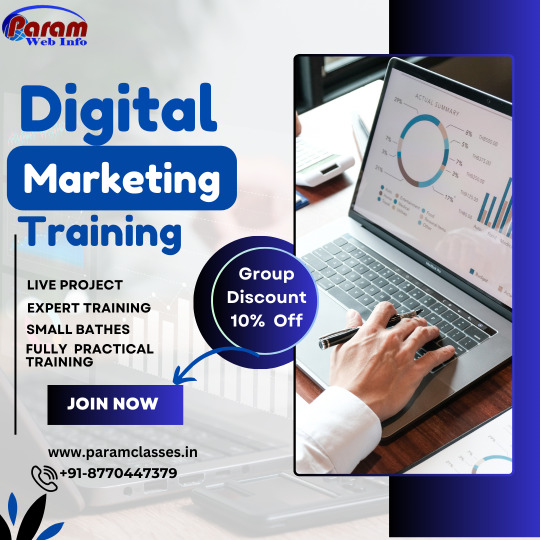
• Digital marketing training provides essential skills for navigating the online landscape. • Covering SEO, social media marketing, PPC advertising, email campaigns, and analytics, it empowers professionals to optimize digital presence, engage audiences, and drive conversions. • Through strategic planning and data analysis, marketers learn to target specific demographics, maximize ROI, and adapt to evolving trends. • Practical exercises and case studies enhance proficiency in platforms like Google Ads, Facebook Business Manager, and email automation tools. • With industry-relevant certifications and hands-on experience, participants gain a competitive edge in today's digital economy. #digitalmarketingtraining #socialmediamarketing #graphicsads #digitalmarketingexpert #paramsirraipur
0 notes
Photo
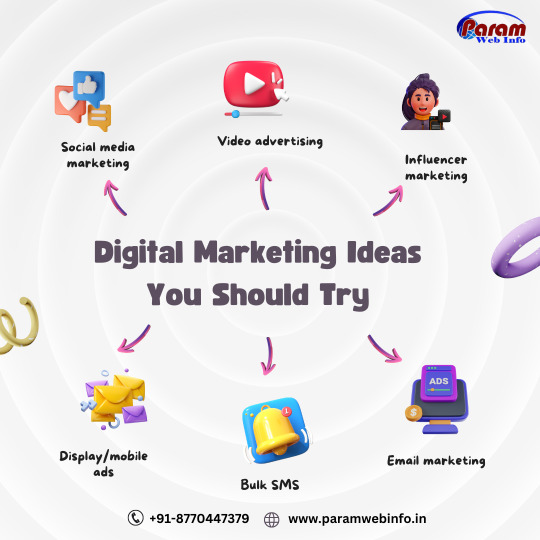
1. Define Clear Goals: • Tip: Establish specific, measurable, achievable, relevant, and time-bound (SMART) goals. • Why: Clear goals guide your strategy and help measure success. • Example: Increase website traffic by 20% in six months. 2. Understand Your Audience: • Tip: Create detailed buyer personas based on demographics, interests, and behaviors. • Why: Knowing your audience allows for targeted and effective marketing. • Example: Target young professionals interested in tech. 3. Content is King: • Tip: Produce high-quality, valuable content regularly. • Why: Engaging content attracts and retains customers. • Example: Blog posts, videos, and infographics. 4. Leverage Social Media: • Tip: Use platforms where your audience is active and post consistently. • Why: Social media enhances brand visibility and engagement. • Example: Instagram for visual content, LinkedIn for B2B marketing. 5. Utilize SEO Best Practices: • Tip: Optimize your website and content for search engines. • Why: SEO increases organic traffic and improves search rankings. • Example: Use relevant keywords, meta tags, and quality backlinks. 6. Email Marketing: • Tip: Build and segment your email list, and personalize your emails. • Why: Email marketing drives conversions and nurtures leads. • Example: Send newsletters, promotional offers, and product updates. 7. Analytics and Monitoring: • Tip: Use tools like Google Analytics to track performance and gather insights. • Why: Data-driven decisions improve strategy effectiveness. • Example: Monitor website traffic, bounce rates, and conversion rates. 8. Engage with Your Audience: • Tip: Respond to comments, messages, and reviews promptly. • Why: Engagement builds community and customer loyalty. • Example: Host Q&A sessions, respond to social media interactions. 9. Leverage Influencer Marketing: • Tip: Partner with influencers relevant to your niche. • Why: Influencers can amplify your reach and credibility. • Example: Collaborate on sponsored posts or product reviews. 10. Paid Advertising: • Tip: Use targeted ads on platforms like Google Ads and social media. • Why: Paid ads drive immediate traffic and conversions. • Example: Run Facebook Ads targeting specific demographics. By following these tips, you can create a robust digital marketing strategy that effectively reaches and engages your audience, ultimately driving growth and success for your business. #digitalmarketing #socialmediamarketing #videomarketin #digitalmarketingexpert #paramsirraipur #paramwebinfo
0 notes
Photo

Designing a logo is a critical task for any designer, as it often serves as the visual cornerstone of a brand. Here are some tips and tricks to help you create effective and memorable logos: Understand the Brand 1. Research the Brand: Understand the brand’s mission, values, target audience, and market position. A logo should reflect the brand’s identity and ethos. 2. Create a Mood Board: Collect images, colors, and typography that resonate with the brand’s personality. This can guide your design process and keep your ideas aligned with the brand’s image. Design Principles 1. Simplicity: Aim for simplicity in your design. A simple logo is more versatile, memorable, and effective across various mediums and sizes. 2. Relevance: Ensure the logo is relevant to the brand’s industry and audience. Avoid generic symbols and strive for unique representation. 3. Versatility: Design a logo that works well in different sizes and formats, including black and white. Test it on various backgrounds and applications. 4. Timelessness: Avoid trends that may become outdated quickly. Aim for a design that will remain effective for many years. Typography and Color 1. Typography: Choose fonts that complement the brand’s personality. Ensure readability and avoid overly complex or trendy fonts. 2. Color Psychology: Use colors that evoke the desired emotions and associations for the brand. Understand color psychology and how different colors can affect perception. 3. Color Palette: Limit the color palette to a few complementary colors to maintain a clean and cohesive look. Creative Process 1. Sketching: Start with rough sketches on paper. This allows for quick exploration of ideas without getting bogged down by digital tools. 2. Digital Refinement: Once you have a few strong concepts, move to digital tools to refine the designs. Use vector graphics software like Adobe Illustrator for scalability. 3. Iterate and Refine: Don’t settle for the first design. Create multiple iterations and refine based on feedback and further consideration. Feedback and Validation 1. Get Feedback: Share your designs with colleagues, stakeholders, or even potential users. Constructive criticism can help improve the design. 2. Mockups: Place the logo on various mockups to see how it looks in real-world applications, such as business cards, websites, and merchandise. 3. A/B Testing: If possible, conduct A/B testing with different logo designs to see which one resonates more with the target audience. Technical Considerations 1. Scalability: Ensure the logo is designed in vector format for scalability without loss of quality. 2. File Formats: Provide the logo in various file formats (e.g., .AI, .EPS, .SVG, .PNG, .JPG) for different uses. 3. Responsive Design: Consider how the logo will appear in different screen sizes and devices, especially for digital-first brands. Legal Considerations 1. Originality: Ensure your design is original and does not infringe on existing trademarks. 2. Trademarking: Once the logo is finalized, consider registering it as a trademark to protect the brand’s identity legally. Inspiration and Continuous Learning 1. Stay Inspired: Keep up with design trends and study successful logos to understand what makes them effective. 2. Continuous Learning: Invest in your skills through courses, workshops, and reading. Design is an ever-evolving field, and staying updated will help you stay ahead. By following these tips and tricks, you can create logos that are not only aesthetically pleasing but also deeply resonant with the brand's identity and audience. #logodesign #logocreative #logodesigning #raipurlogodesign #2dlogo #3dlogo #paramwebinfo
0 notes
Photo
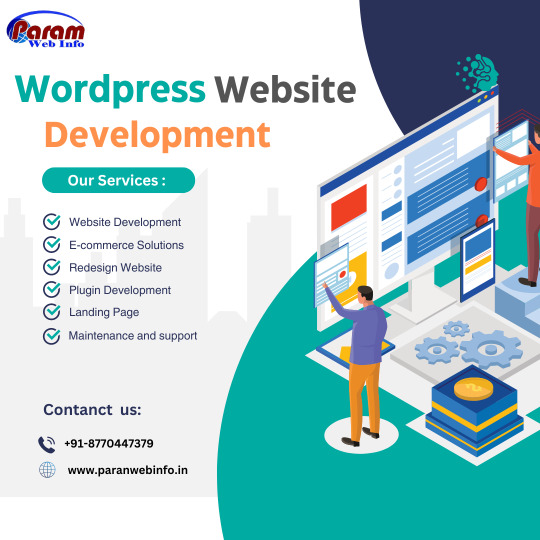
When developing a WordPress website, there are several core features and best practices to consider to ensure a robust, user-friendly, and secure website. Here are the key features: 1. User-Friendly Navigation • Custom Menus: Easily create and manage menus. • Breadcrumbs: Enhance navigation with breadcrumb trails. • Search Functionality: Utilize built-in or enhanced search features. 2. Responsive Design • Mobile-Friendly Themes: Choose themes that are responsive out-of-the-box. • Responsive Plugins: Ensure plugins and widgets are mobile-compatible. 3. Performance Optimization • Caching Plugins: Use plugins like W3 Total Cache or WP Super Cache. • Image Optimization: Utilize plugins like Smush or ShortPixel. • Minification: Minify CSS, JavaScript, and HTML using plugins like Autoptimize. 4. Content Management System (CMS) • Gutenberg Editor: Use the block editor for easy content creation. • Custom Post Types: Create custom post types for different content needs. • Media Library: Efficiently manage images, videos, and other media. 5. Security Features • Security Plugins: Install plugins like Wordfence or Sucuri for enhanced security. • Regular Updates: Keep WordPress core, themes, and plugins updated. • SSL Certificate: Ensure your site has an SSL certificate for HTTPS. 6. SEO Optimization • SEO Plugins: Use plugins like Yoast SEO or All in One SEO Pack. • XML Sitemaps: Automatically generate sitemaps with SEO plugins. • Clean Permalinks: Set up SEO-friendly URLs. 7. Analytics and Reporting • Google Analytics Integration: Track website performance with plugins like MonsterInsights. • Dashboard Widgets: View analytics directly from the WordPress dashboard. 8. Social Media Integration • Social Sharing Plugins: Use plugins like Social Warfare or ShareThis. • Social Feeds: Display social media feeds with plugins like Smash Balloon. 9. Contact and Support Options • Contact Form Plugins: Use plugins like Contact Form 7 or WPForms. • Live Chat: Integrate live chat with plugins like Tawk.to or LiveChat. • FAQs: Create an FAQ section using custom post types or plugins. 10. High-Quality Content • Engaging Text: Write clear and engaging content. • Multimedia Integration: Easily add images, videos, and other media. 11. Accessibility • WCAG Compliance: Use themes and plugins that support accessibility standards. • Accessibility Plugins: Implement plugins like WP Accessibility. 12. E-commerce Functionality (if applicable) • WooCommerce: Install and configure WooCommerce for online stores. • Product Management: Manage products, categories, and inventory. • Payment Gateways: Integrate various payment methods. 13. Regular Maintenance • Backup Solutions: Use plugins like UpdraftPlus or BackupBuddy for regular backups. • Maintenance Mode: Utilize maintenance mode plugins when performing updates. 14. Customization and Flexibility • Themes and Page Builders: Use customizable themes and page builders like Elementor or Divi. • Custom Widgets and Shortcodes: Enhance functionality with custom widgets and shortcodes. 15. User Management • Role Management: Assign different roles and permissions. • Membership Plugins: Use plugins for membership sites if needed. By incorporating these core features, a WordPress website can be highly functional, secure, and user-friendly, providing a positive experience for both administrators and visitors #wordpresswebsitefeature #wordpresswebsite #wordpressdevelopment #wordpressinraipur #landingpagewebsite #wordpresslandingpage #paramwebinfo
0 notes
Photo
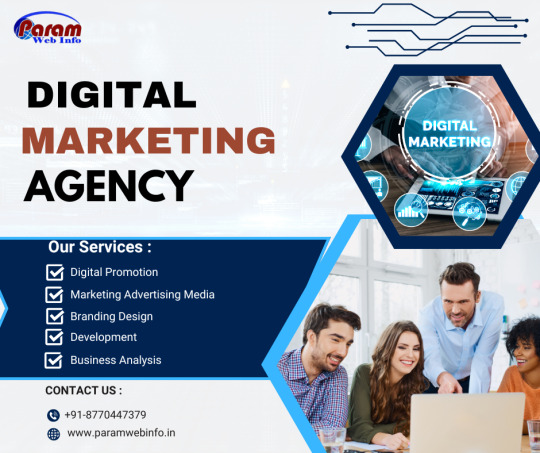
Digital marketing at an expert level involves a deep understanding of various channels, advanced strategies, and the ability to leverage data and technology to drive business growth. Here’s an in-depth look into key areas for expert-level digital marketing: 1. Advanced SEO (Search Engine Optimization) • Technical SEO: Ensure your website architecture, URLs, mobile-friendliness, site speed, and indexability are optimized. Use tools like Google Search Console, Screaming Frog, and SEMrush for audits and fixes. • Content Strategy: Develop high-quality, evergreen content that targets strategic keywords and integrates semantic SEO practices. Utilize tools like Surfer SEO and Clearscope for content optimization. • Link Building: Focus on acquiring high-quality backlinks through digital PR, guest blogging, and influencer outreach. Employ advanced link-building strategies such as skyscraper techniques and broken link building. 2. Advanced PPC (Pay-Per-Click) Advertising • Google Ads and Bing Ads Mastery: Use advanced features like custom audiences, remarketing lists, and automated bidding strategies. Utilize scripts and APIs for campaign management. • Programmatic Advertising: Leverage real-time bidding (RTB) and data management platforms (DMPs) to deliver highly targeted ads. Understand and use demand-side platforms (DSPs) like The Trade Desk. • Advanced Analytics: Utilize advanced features in Google Analytics, Google Tag Manager, and attribution modeling to track performance and ROI accurately. Implement multi-touch attribution to understand the customer journey better. 3. Social Media Marketing • Platform Specialization: Develop deep expertise in platforms like Facebook, Instagram, LinkedIn, TikTok, and Twitter. Understand the algorithms and advanced targeting options each platform offers. • Social Listening and Sentiment Analysis: Use tools like Brandwatch, Sprout Social, and Hootsuite Insights to monitor brand mentions and audience sentiment. • Advanced Content Creation: Invest in high-quality video production, interactive content, and augmented reality (AR) experiences. Utilize tools like Canva Pro, Adobe Creative Cloud, and Lumen5 for professional-grade content. 4. Email Marketing • Segmentation and Personalization: Implement advanced segmentation strategies and use dynamic content to personalize emails. Tools like HubSpot, Mailchimp, and Klaviyo can be very effective. • Automated Workflows: Create complex automation sequences based on user behavior and lifecycle stage. Use A/B testing and predictive analytics to optimize email performance. • Deliverability Optimization: Focus on improving email deliverability by maintaining a clean list, using double opt-in, and monitoring sender reputation through tools like Litmus and Return Path. 5. Content Marketing • Content Pillars and Clusters: Develop comprehensive content strategies that revolve around pillar content and topic clusters to improve SEO and user engagement. • Interactive Content: Create interactive infographics, quizzes, calculators, and other engaging content types. Tools like Ceros and Outgrow can help. • Content Distribution: Use paid and organic channels to distribute content effectively. Consider syndication, partnerships, and influencer collaborations. 6. Analytics and Data-Driven Marketing • Advanced Analytics Tools: Use Google Analytics 4, Adobe Analytics, and Mixpanel for in-depth data analysis. Implement custom dashboards and reports to track KPIs. • Data Integration and Visualization: Integrate data from various sources using tools like Google Data Studio, Tableau, and Power BI. Visualize complex data sets to derive actionable insights. • Predictive Analytics: Employ machine learning models and predictive analytics to forecast trends and customer behavior. Tools like SAS, RapidMiner, and IBM Watson can be valuable. 7. Conversion Rate Optimization (CRO) • User Experience (UX) Optimization: Conduct UX audits and usability testing to improve website and landing page performance. Use tools like Hotjar, Crazy Egg, and Optimizely. • A/B and Multivariate Testing: Run systematic A/B and multivariate tests to optimize conversion elements. Tools like VWO and Convert.com are useful. • Behavioral Analytics: Analyze user behavior using heatmaps, session recordings, and funnel analysis to identify drop-offs and improvement areas. 8. Marketing Automation and CRM • Advanced CRM Systems: Utilize advanced features in CRM systems like Salesforce, HubSpot CRM, and Zoho CRM to manage customer relationships effectively. • Marketing Automation: Implement sophisticated automation workflows using tools like Marketo, Pardot, and ActiveCampaign to nurture leads and streamline marketing tasks. • Lead Scoring and Nurturing: Develop advanced lead scoring models and nurture sequences based on user behavior, engagement, and demographics. #digitalmarketing #websitedevelopment #paramwebinfo #brandingdesign #businessmarketing
0 notes
Photo
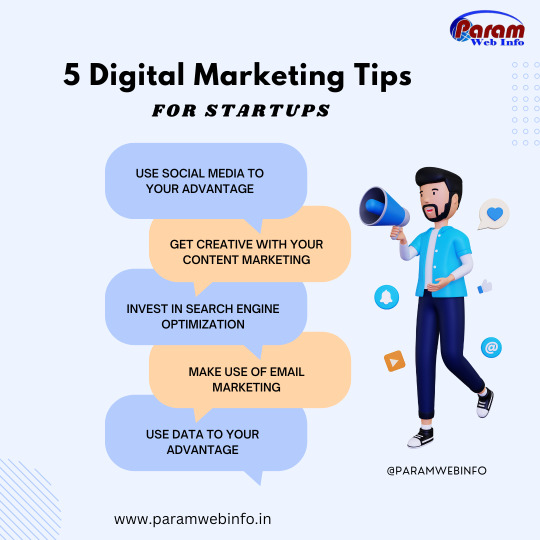
Use social media to your advantage Get creative with your content marketing Invest in search engine optimization Make use of email marketing Use data to your advantage #paramwebinfo #digitapmarketingtips #contentmarketingtips #internetmarketingtips #socialmediamarketingtips #paramsirraipur
0 notes
Photo
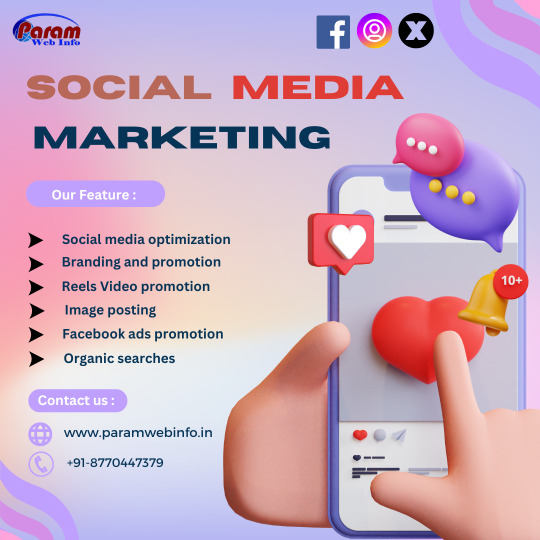
Social Media Optimization (SMO) is essential for enhancing your online presence and improving your SEO (Search Engine Optimization) efforts. Here are some practical tips for optimizing your social media to support your SEO strategy: 1. Optimize Your Profiles • Complete All Fields: Ensure all profile fields are filled out comprehensively with relevant keywords. • Use Consistent Branding: Maintain consistent branding across all social platforms, including profile pictures, cover photos, and bios. • Link to Your Website: Include a link to your website in your profile bio and ensure it’s easily accessible. 2. Keyword Integration • Keyword Research: Use tools like Google Keyword Planner or SEMrush to find relevant keywords. • Incorporate Keywords: Naturally incorporate these keywords into your posts, bios, and hashtags. 3. Content Strategy • Quality Content: Post high-quality, engaging content that provides value to your audience. • Variety of Formats: Use a mix of content types, including text, images, videos, infographics, and links. • Regular Posting: Maintain a consistent posting schedule to keep your audience engaged and coming back for more. 4. Engagement • Respond to Comments: Engage with your audience by responding to comments and messages promptly. • Ask Questions: Encourage interaction by asking questions and prompting discussions. • User-Generated Content: Share content created by your followers to foster a sense of community. 5. Use Hashtags Wisely • Relevant Hashtags: Use hashtags that are relevant to your content and industry. • Trending Hashtags: Participate in trending hashtags when appropriate to increase visibility. • Branded Hashtags: Create and promote your own branded hashtags to build brand recognition. 6. Cross-Promote • Link to Social Media on Your Website: Add social media buttons to your website to make it easy for visitors to follow you. • Share Website Content: Regularly share your blog posts and other website content on your social media channels. • Embed Social Feeds: Embed your social media feeds on your website to showcase your activity and encourage followers. 7. Use Social Media Tools • Analytics Tools: Use tools like Google Analytics, Facebook Insights, and Twitter Analytics to track performance and understand what content resonates with your audience. • Scheduling Tools: Use tools like Hootsuite, Buffer, or Sprout Social to schedule posts and manage your social media strategy efficiently. 8. Leverage Influencers • Collaborate with Influencers: Partner with influencers in your industry to increase your reach and credibility. • User Reviews and Testimonials: Encourage satisfied customers to share their experiences on social media. 9. Local SEO • Geotagging: Use geotags in your posts to target local audiences. • Local Keywords: Incorporate local keywords into your social media content to improve local search visibility. 10. Monitor and Adjust • Track Performance: Regularly monitor your social media performance and adjust your strategy based on what’s working and what’s not. • Stay Updated: Keep up with social media trends and algorithm changes to ensure your strategy remains effective. 11. Social Sharing Buttons • Add to Blog Posts: Ensure your blog posts and other website content have social sharing buttons to make it easy for visitors to share your content. • Encourage Sharing: Prompt your audience to share your content to increase its reach and engagement. By implementing these social media optimization tips, you can enhance your SEO efforts, drive more traffic to your website, and improve your overall online presence. #socialmediamarketing #socialmediatips #socialmediatricks #facebookadsmarketing #raipurbusiness #paramwebinfo
0 notes
Photo

Here are some key features and aspects to consider when designing a brochure: 1. Purpose and Audience: Understand the purpose of the brochure and the audience it's intended for. This will guide your design decisions and content selection. 2. Layout and Structure: Determine the layout and structure of the brochure, including the number of folds, orientation (portrait or landscape), and panel arrangement. Common formats include bi-fold, tri-fold, and z-fold. 3. Visual Elements: • Images: Use high-quality images and graphics that are relevant to the content and visually appealing. Consider using professional photography or illustrations. • Color Scheme: Choose a cohesive color scheme that aligns with your brand identity and conveys the desired message. Ensure readability by using contrasting colors for text and background. • Typography: Select appropriate fonts that are easy to read and complement the overall design. Use different font styles (e.g., bold, italic) to emphasize key points. 4. Content: • Headlines and Titles: Create clear and engaging headlines and titles that capture the reader's attention and communicate the main message. • Body Text: Keep the body text concise, informative, and well-organized. Use bullet points, short paragraphs, and subheadings to improve readability. • Call-to-Action (CTA): Include a compelling call-to-action that prompts the reader to take the desired action, whether it's visiting a website, making a purchase, or contacting your business. 5. White Space: Use white space effectively to prevent the brochure from appearing cluttered and overwhelming. Allow breathing room around text and images to improve readability and visual appeal. 6. Brand Consistency: Ensure consistency with your brand's visual identity, including logo placement, color usage, and messaging tone. 7. Printing Considerations: Keep printing specifications in mind when designing the brochure, such as bleed, trim size, and resolution requirements. Work with a professional printer to ensure high-quality printing results. 8. Proofreading: Thoroughly proofread the content for grammar, spelling, and factual errors before finalizing the design. Consider seeking feedback from colleagues or stakeholders to catch any overlooked mistakes. #brochuredesigning #brochuredesigningraipur #paramwebinfo #paramsirraipur
0 notes
Photo

Website development encompasses various types, each catering to different needs, functionalities, and purposes. Here are some common types of website development: Static Websites: Static websites consist of web pages with fixed content that doesn't change unless manually updated by a developer. They are simple and easy to create, suitable for small businesses, portfolios, or informational websites with minimal interactivity. Dynamic Websites: Dynamic websites are built using server-side technologies such as PHP, Python, or Ruby on Rails. Content on dynamic websites is generated dynamically based on user interactions, database queries, or other external data sources. They are ideal for websites that require frequent content updates, user interactions, e-commerce functionalities, or personalized content delivery. E-commerce Websites: E-commerce websites are designed for buying and selling products or services online. They include features like product catalogs, shopping carts, payment gateways, order management systems, and customer accounts. Platforms like Shopify, WooCommerce (WordPress), Magento, and BigCommerce are commonly used for building e-commerce websites. Content Management Systems (CMS): CMS platforms like WordPress, Joomla, Drupal, and Squarespace provide a user-friendly interface for creating, managing, and updating website content. They offer customizable themes, plugins, and extensions to add functionality and design flexibility. CMS websites are suitable for blogs, news websites, corporate websites, and small to medium-sized businesses. Web Applications: Web applications are interactive software programs accessed through web browsers. They offer functionalities similar to traditional desktop applications but are accessed over the internet. Examples include email clients, social media platforms, project management tools, and online banking systems. Single Page Applications (SPAs): SPAs load a single HTML page dynamically and update the content dynamically as the user interacts with the application. They offer a smoother, more seamless user experience compared to traditional multi-page websites. SPAs are commonly built using JavaScript frameworks like React.js, AngularJS, or Vue.js. Progressive Web Apps (PWAs): PWAs combine the features of websites and mobile apps to deliver a fast, reliable, and engaging user experience. They can work offline, send push notifications, and provide app-like interactions, making them ideal for mobile users. PWAs use modern web technologies like service workers, HTTPS, and responsive design. Responsive and Mobile Websites: Responsive websites adapt their layout and design based on the user's device screen size, ensuring a consistent user experience across desktops, tablets, and smartphones. Mobile websites are specifically designed and optimized for mobile devices, prioritizing fast loading times, simplified navigation, and touch-friendly interactions. Portal Websites: Portal websites serve as gateways to a variety of resources, services, or information, often organized into categories or sections. They may include features like user authentication, personalized content delivery, and integration with external systems or APIs. Landing Pages: Landing pages are standalone web pages designed for specific marketing campaigns, promotions, or product launches. They are optimized to convert visitors into leads or customers and typically feature a clear call-to-action (CTA) and minimal distractions. Choosing the right type of website development depends on factors such as the nature of the business, target audience, budget, functionality requirements, and long-term goals. #websitedevelopmenttype #websitedesigninginraipur #websiteexpert #raipuriens #paramwebinfo #paramsirraipur
0 notes
Photo
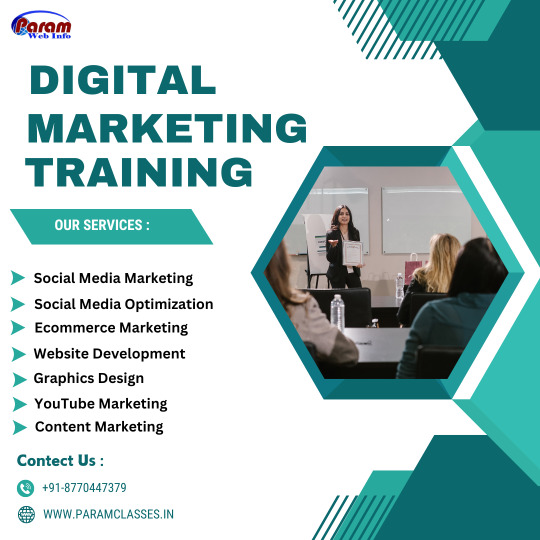
Digital marketing training provides essential skills for navigating the online landscape. Covering SEO, social media marketing, PPC advertising, email campaigns, and analytics, it empowers professionals to optimize digital presence, engage audiences, and drive conversions. Through strategic planning and data analysis, marketers learn to target specific demographics, maximize ROI, and adapt to evolving trends. Practical exercises and case studies enhance proficiency in platforms like Google Ads, Facebook Business Manager, and email automation tools. With industry-relevant certifications and hands-on experience, participants gain a competitive edge in today's digital economy. #digitalmarketingtraining #socialmediamarketing #graphicsads #digitalmarketingexpert #paramsirraipur
0 notes
Photo

Elevate Your Brand with Stunning Designs! Our graphic design agency specializes in creating captivating visuals that resonate with your audience. From eye-catching logos to engaging social media graphics, we've got you covered. Check out our portfolio for a glimpse of our creative prowess. Let's turn your vision into reality! #GraphicDesign #CreativeAgency #graphicsdesigningraipur #paramwebinfo
0 notes
Photo
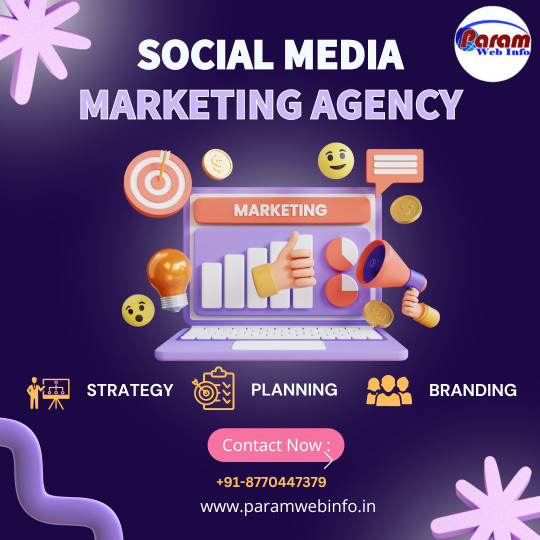
here are some quick tips and tricks for social media optimization (SMO): Consistent Branding: Maintain consistent branding across all social media platforms to create a cohesive brand identity. Engaging Content: Create and share engaging content that resonates with your target audience to encourage interaction and sharing. Optimize Profiles: Optimize your social media profiles with relevant keywords, a compelling bio, and high-quality images to improve visibility and attract followers. Use Hashtags Wisely: Use relevant hashtags to increase the discoverability of your posts and reach a wider audience. Visual Content: Incorporate visually appealing content such as images, videos, and infographics to capture attention and increase engagement. Schedule Posts: Use scheduling tools to plan and schedule posts in advance to maintain a consistent posting schedule and save time. Monitor Analytics: Regularly monitor analytics to track the performance of your social media efforts and make data-driven decisions for optimization. Interact with Followers: Engage with your audience by responding to comments, messages, and mentions to build relationships and foster community engagement. Collaborate with Influencers: Partner with influencers or industry experts to amplify your reach and credibility within your niche. Stay Updated: Stay updated with the latest social media trends and algorithm changes to adapt your strategy accordingly and stay ahead of the competition. #smo #socialmediamarketing #socialmedia #raipurians #paramwebinfo #digitalmarketing #digitalmarketinginraipur #paramsirraipur
0 notes
Photo




here are some concise digital marketing tricks: SEO Optimization: Improve website visibility through keyword research and on-page optimization. Social Media Engagement: Connect with audiences on platforms like Facebook, Instagram, and Twitter to build brand awareness. Email Sequencing: Use targeted emails to nurture leads and promote products. PPC Advertising: Run paid ads on search engines and social media to reach potential customers. Influencer Partnerships: Collaborate with influencers to reach their followers and expand your audience. Remarketing Tactics: Target users who have interacted with your brand to encourage conversions. User-Generated Content: Encourage customers to create and share content, boosting brand credibility. Marketing Automation: Streamline repetitive tasks like email campaigns and social media posting for efficiency. #digitalmarketing #socialmediamarketing #graphicsdesigning #paramsirraipur #paramwebinfo #websitedevelopment #websitedesigning
0 notes
Photo

Here's a brief overview of some common graphics design features: Layers: Most graphic design software allows you to work with multiple layers, enabling you to separate elements of your design and manipulate them independently. Text Tools: Text tools allow you to add and customize text within your design. This includes choosing fonts, sizes, colors, alignment, and more. Drawing Tools: Drawing tools enable you to create shapes, lines, and freehand drawings. These tools often include options for adjusting stroke, fill, and other properties. Selection Tools: Selection tools allow you to select and manipulate specific parts of your design. This can include tools for selecting by shape, color, or area. Transformations: Transformation tools enable you to resize, rotate, skew, and distort elements of your design. Color Adjustment: Graphic design software typically includes tools for adjusting colors, including brightness, contrast, saturation, and hue. Filters and Effects: Many programs offer a variety of filters and effects that can be applied to elements of your design to achieve different looks and styles. Exporting and File Formats: Finally, graphic design software allows you to export your designs in various file formats, such as JPEG, PNG, PDF, etc., suitable for different purposes like printing, web publishing, or further editing. These are just some of the fundamental features found in graphic design software, but there are many more specialized tools and functions available depending on the specific program you're using. #paramwebinfo #paramsir #graphicsdesigning
0 notes
Photo
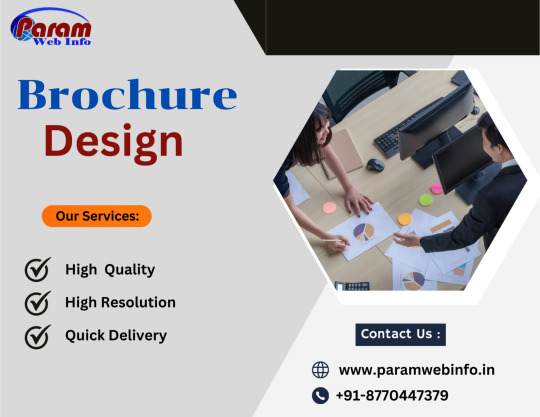
When it comes to designing a brochure, the main features you'll want to focus on include: Eye-catching Design: Your brochure should have a visually appealing layout with attention-grabbing colors, imagery, and typography to draw readers in. Clear Messaging: Ensure that your key message is communicated clearly and concisely throughout the brochure. Use headlines, subheadings, and bullet points to break up text and make it easy for readers to digest. High-Quality Imagery: Use high-resolution images and graphics that are relevant to your message and help to enhance the overall design of the brochure. Branding Elements: Incorporate your company's branding elements such as logos, colors, and fonts to maintain consistency and reinforce your brand identity. Call-to-Action (CTA): Include a compelling call-to-action that encourages readers to take the next step, whether it's visiting your website, contacting you for more information, or making a purchase. Readable Font: Choose a font that is easy to read, both in print and at a distance, to ensure that your message is accessible to all readers. Whitespace: Don't overcrowd your brochure with text and images. Use whitespace strategically to create breathing room and guide the reader's eye through the content. Quality Printing and Paper: Invest in high-quality printing and paper stock to give your brochure a professional look and feel that reflects positively on your brand. Versatility: Design your brochure in a way that allows for easy adaptation to different formats, such as digital versions for online distribution or smaller handouts for events. Audience Focus: Keep your target audience in mind throughout the design process and tailor the content and visuals to resonate with their interests, preferences, and needs. #brochuredesigning #brochuredesigninginraipur #brochuredesigningchhattisgarh #paramwebinfo #paramsirraipur #paramsir #raipurbusiness #graphicsdesigning
0 notes
Photo
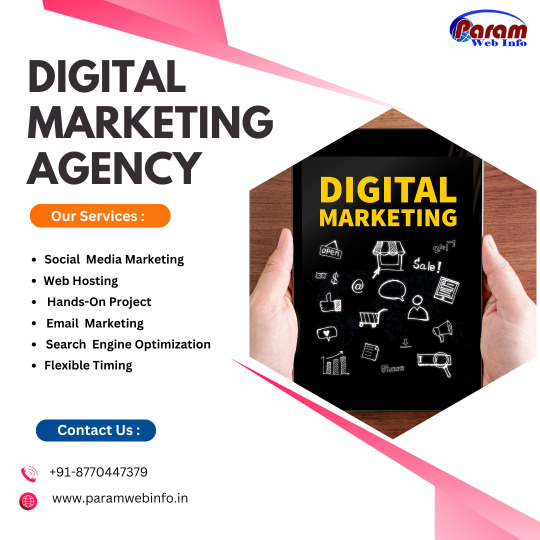
Some digital marketing tips for promoting business Know Your Audience: Understand your target audience's demographics, preferences, and behavior to tailor your marketing efforts effectively. Create Quality Content: Produce engaging and valuable content that resonates with your audience. This could be blog posts, videos, infographics, podcasts, etc. Optimize for SEO: Implement search engine optimization (SEO) strategies to improve your website's visibility in search engine results. This includes keyword research, on-page optimization, and building quality backlinks. Utilize Social Media: Choose the platforms where your audience is most active and engage with them regularly. Post relevant content, interact with followers, and use paid advertising to amplify your reach. Email Marketing: Build an email list of subscribers interested in your products or services. Send targeted and personalized emails to nurture leads and encourage conversions. Leverage Influencers: Collaborate with influencers in your industry to reach a wider audience and build credibility for your brand. Track and Analyze Data: Use analytics tools to monitor the performance of your marketing campaigns. Analyze metrics such as website traffic, conversion rates, and engagement to optimize your strategies. Mobile Optimization: Ensure that your website and content are optimized for mobile devices, as a significant portion of internet users access content through smartphones and tablets. Experiment and Adapt: Stay updated with the latest trends and technologies in digital marketing. Be willing to experiment with new strategies and adapt your approach based on the results. Provide Value: Ultimately, focus on providing value to your audience rather than just promoting your products or services. Building trust and relationships with your customers will lead to long-term success. #digitalmarketing #socialmediamarketing #websitedevelopment #wordpressdesign #paramwebinfo #facebookads #googleads
0 notes
Photo
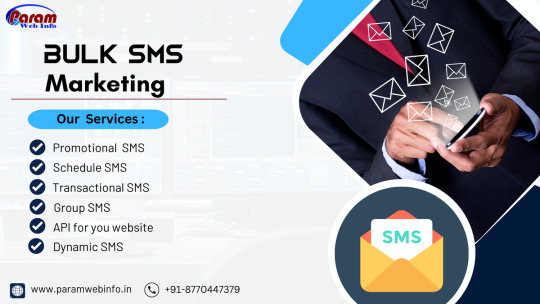
SMS marketing and IVR system services in Paramwebinfo SMS Marketing: Definition: SMS (Short Message Service) marketing involves sending promotional messages or alerts to customers via text messages. Key Features: Instant Delivery: SMS messages are delivered almost instantly, ensuring timely communication. High Open Rates: SMS messages typically have high open rates compared to emails. Direct Communication: Allows for direct and concise communication with customers. Personalization: Messages can be personalized based on customer data. Cost-Effective: Generally more affordable than traditional marketing channels. Opt-in and Opt-out: Requires opt-in from recipients and offers easy opt-out options for compliance. Use Cases: Promotional offers and discounts Order confirmations and updates Appointment reminders Customer surveys and feedback collection Event notifications IVR Services: Definition: IVR (Interactive Voice Response) is an automated telephony system that interacts with callers, gathers information, and routes calls to the appropriate recipient. Key Features: Call Routing: Routes calls to the appropriate department or agent based on caller input. Information Gathering: Collects information from callers through voice or keypad responses. 24/7 Availability: Provides round-the-clock customer service without human intervention. Efficiency: Handles a high volume of calls simultaneously. Personalization: Can be tailored with custom greetings and responses based on caller data. Integration: Integrates with CRM systems for streamlined customer data management.
0 notes